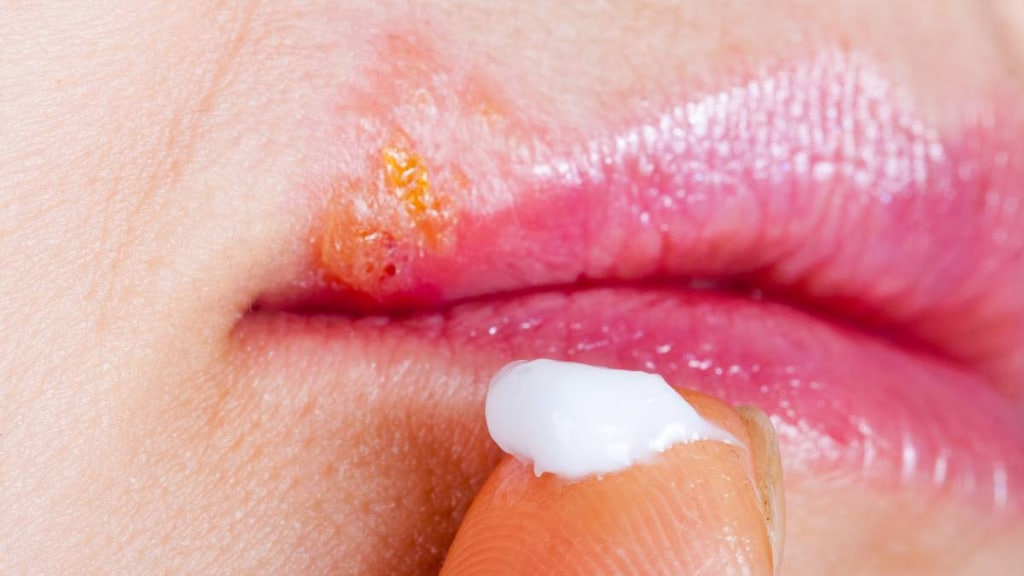Dosage Forms
Excipient information presented when available (limited, particularly for generics); consult specific product labeling.
Cream, External:
Xerese: Acyclovir 5% and hydrocortisone 1% (5 g) [contains cetostearyl alcohol, propylene glycol]
Pharmacology
Mechanism of Action
Acyclovir: Acyclovir is converted to acyclovir monophosphate by virus-specific thymidine kinase then further converted to acyclovir triphosphate by other cellular enzymes. Acyclovir triphosphate inhibits DNA synthesis and viral replication by competing with deoxyguanosine triphosphate for viral DNA polymerase and being incorporated into viral DNA.
Hydrocortisone: Topical corticosteroids have anti-inflammatory, antipruritic, and vasoconstrictive properties.
Use: Labeled Indications
Herpes labialis: Treatment of recurrent herpes labialis (cold sores) in children ≥6 years and adults.
Contraindications
There are no contraindications listed in the manufacturer’s US labeling.
Canadian labeling:Known or suspected history of hypersensitivity to acyclovir, valacyclovir, hydrocortisone or any component of the cream.
Dosage and Administration
Dosing: Adult
Herpes labialis (cold sores): Topical: Apply 5 times/day for 5 days
Dosing: Geriatric
Refer to adult dosing.
Dosing: Pediatric
Herpes labialis (cold sores): Children ≥6 years and Adolescents: Topical: Apply 5 times daily for 5 days; initiate therapy at first sign of infection (ie, during the prodrome or when lesions appear)
Administration
For external use only; not for use in the eye, inside the mouth or nose, or on the genitals. Wash hands before and after application. Use sufficient amount to cover the affected area(s), including the outer margin of cold sore; do not rub affected area. Initiate therapy early (ie, during the prodrome or when lesions appear).
Storage
Store at 20°C to 25°C (68°F to 77°F); excursions permitted to 15°C to 30°C (59°F to 86°F); do not freeze.
Drug Interactions
Aldesleukin: Corticosteroids may diminish the antineoplastic effect of Aldesleukin. Avoid combination
Calcipotriene: Hydrocortisone (Topical) may diminish the therapeutic effect of Calcipotriene. Management: Monitor for reduced calcipotriene efficacy if combined with hydrocortisone valerate. Consider separating the administration of these agents by 10 to 12 hours to minimize the risk of this potential interaction. Monitor therapy
Corticorelin: Corticosteroids may diminish the therapeutic effect of Corticorelin. Specifically, the plasma ACTH response to corticorelin may be blunted by recent or current corticosteroid therapy. Monitor therapy
Deferasirox: Corticosteroids may enhance the adverse/toxic effect of Deferasirox. Specifically, the risk for GI ulceration/irritation or GI bleeding may be increased. Monitor therapy
Hyaluronidase: Corticosteroids may diminish the therapeutic effect of Hyaluronidase. Management: Patients receiving corticosteroids (particularly at larger doses) may not experience the desired clinical response to standard doses of hyaluronidase. Larger doses of hyaluronidase may be required. Consider therapy modification
Ritodrine: Corticosteroids may enhance the adverse/toxic effect of Ritodrine. Monitor therapy
Talimogene Laherparepvec: Antiherpetic Antivirals may diminish the therapeutic effect of Talimogene Laherparepvec. Monitor therapy
Adverse Reactions
<1%, postmarketing, and/or case reports: Allergic contact sensitivity, application site reaction, burning sensation of skin, contact dermatitis (when applied under occlusion), dyschromia, erythema, exfoliation of skin, tingling of skin, xeroderma
Warnings/Precautions
Concerns related to adverse effects:
- Sensitization: Use has been associated with local sensitization (irritation).
Disease-related concerns:
- Herpes labialis: Appropriate use: Treatment should begin with the first signs or symptoms. For external use only to the lips and around the mouth; do not apply to eye, inside the mouth or nose, or on the genitals. Contact healthcare provider if cold sore does not heal in 2 weeks.
Concurrent drug therapy issues:
- Drug-drug interactions: Potentially significant interactions may exist, requiring dose or frequency adjustment, additional monitoring, and/or selection of alternative therapy. Consult drug interactions database for more detailed information.
Special populations:
- Immunocompromised patients: Use with caution in immunocompromised patients.
Pregnancy
Pregnancy Considerations
Systemic exposure of acyclovir and hydrocortisone after topical administration is minimal.
Refer to individual monographs for additional information.
Patient Education
What is this drug used for?
- It is used to treat cold sores.
Frequently reported side effects of this drug
- Dry skin
- Burning
- Skin tingling
- Skin discoloration
- Skin irritation
- Signs of a significant reaction like wheezing; chest tightness; fever; itching; bad cough; blue skin color; seizures; or swelling of face, lips, tongue, or throat.
Note: This is not a comprehensive list of all side effects. Talk to your doctor if you have questions.
Consumer Information Use and Disclaimer: This information should not be used to decide whether or not to take this medicine or any other medicine. Only the healthcare provider has the knowledge and training to decide which medicines are right for a specific patient. This information does not endorse any medicine as safe, effective, or approved for treating any patient or health condition. This is only a brief summary of general information about this medicine. It does NOT include all information about the possible uses, directions, warnings, precautions, interactions, adverse effects, or risks that may apply to this medicine. This information is not specific medical advice and does not replace information you receive from the healthcare provider. You must talk with the healthcare provider for complete information about the risks and benefits of using this medicine.
